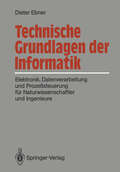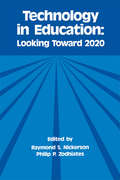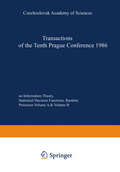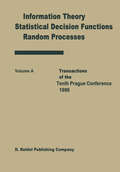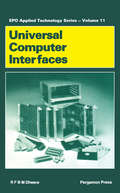- Table View
- List View
Technische Grundlagen der Informatik: Elektronik, Datenverarbeitung und Prozeßsteuerung für Naturwissenschaftler und Ingenieure
by Dieter EbnerTechnology in Education: Looking Toward 2020 (Technology and Education Series)
by RAYMOND S. NICKERSON, PHILIP P. ZODHIATESSome of today's educational experts were asked to envision the year 2020, when technology has assumed a major role in elementary and secondary education. The informed conjecture that followed is contained in this volume; contributors offer visions of the future as well as specific steps that could turn those visions into realities. Innovative ideas for research, development, hardware, software, teacher training, technical assistance, organizational and cultural change are offered as a means to illuminate the potential role of technology in the educational systems of tomorrow. Technology in Education is a thought-provoking statement of what can and should be done to advance the application of technology to education over the next few decades. As such, it should be read by all researchers and professionals in educational technology.
Technology in Education: Looking Toward 2020 (Technology and Education Series)
by Raymond S. Nickerson Philip P. ZodhiatesSome of today's educational experts were asked to envision the year 2020, when technology has assumed a major role in elementary and secondary education. The informed conjecture that followed is contained in this volume; contributors offer visions of the future as well as specific steps that could turn those visions into realities. Innovative ideas for research, development, hardware, software, teacher training, technical assistance, organizational and cultural change are offered as a means to illuminate the potential role of technology in the educational systems of tomorrow. Technology in Education is a thought-provoking statement of what can and should be done to advance the application of technology to education over the next few decades. As such, it should be read by all researchers and professionals in educational technology.
Testing and Diagnosis of VLSI and ULSI (NATO Science Series E: #151)
by F. Lombardi M. G. SamiThis volume contains a collection of papers presented at the NATO Advanced Study Institute on ·Testing and Diagnosis of VLSI and ULSI" held at Villa Olmo, Como (Italy) June 22 -July 3,1987. High Density technologies such as Very-Large Scale Integration (VLSI), Wafer Scale Integration (WSI) and the not-so-far promises of Ultra-Large Scale Integration (ULSI), have exasperated the problema associated with the testing and diagnosis of these devices and systema. Traditional techniques are fast becoming obsolete due to unique requirements such as limited controllability and observability, increasing execution complexity for test vector generation and high cost of fault simulation, to mention just a few. New approaches are imperative to achieve the highly sought goal of the • three months· turn around cycle time for a state-of-the-art computer chip. The importance of testing and diagnostic processes is of primary importance if costs must be kept at acceptable levels. The objective of this NATO-ASI was to present, analyze and discuss the various facets of testing and diagnosis with respect to both theory and practice. The contents of this volume reflect the diversity of approaches currently available to reduce test and diagnosis time. These approaches are described in a concise, yet clear way by renowned experts of the field. Their contributions are aimed at a wide readership: the uninitiated researcher will find the tutorial chapters very rewarding. The expert wiII be introduced to advanced techniques in a very comprehensive manner.
Testmustergenerierung und Fehlersimulation in digitalen Schaltungen mit hoher Komplexität (Informatik-Fachberichte #173)
by Michael H. SchulzDas Buch behandelt die beiden wichtigsten Aufgabenstellungen im Rahmen des wirtschaftlich und wissenschaftlich äußerst bedeutenden Gebietes der Testvorbereitung: die automatische Testmustergenerierung und die Fehlersimulation. Alle im Buch beschriebenen Methoden und Verfahren zielen zum einen auf die Minimierung des dazu erforderlichen Rechenzeitaufwandes und zum anderen auf die Bewältigung möglichst großer Schaltungskomplexitäten. Besonderer Wert wurde auf eine präzise, formal konsistente und illustrative Beschreibung und auf eine möglichst vollständige Aufbereitung der einschlägigen Literatur und somit des Standes der Technik gelegt. Das Buch enthält eine Fülle neuer Methoden, die eine wesentliche Beschleunigung von Testmustergenerierungs- und Fehlersimulationsverfahren ermöglichen, und dokumentiert den mit diesen Methoden erzielten Fortschritt anhand einer Reihe von vergleichenden Untersuchungen. Außerdem wird mit SOCRATES das derzeit leistungsfähigste der aus der Literatur bekannten Testmustergenerierungssysteme detailliert vorgestellt. Neben der Hilfestellung bei Implementierungsaufgaben gibt das Buch eine detaillierte Darstellung der Problematik des Testens integrierter Schaltungen und speziell der Prinzipien der automatischen Testmustergenerierung und der schnellen Fehlersimulation. Darüber hinaus kann es als Richtschnur für Spezialvorlesungen nach dem Vordiplom (Elektrotechnik und Informatik) dienen sowie als Ansatz- und Ausgangspunkt für Forschungsaktivitäten auf verwandten Forschungsgebieten.
Theoretical Foundations of Computer Graphics and CAD (NATO ASI Subseries F: #40)
by J. E. Bresenham R. A. Earnshaw R. I. Forrest R. J. Lansdown M.L.V. PittewayAn Advanced Study Institute on the theme "Theoretical Foundations of Computer Graphics and CAD" was held in II Ciocco, Italy, 4-17 July, 1987 under the auspices of the Scientific Affairs Division of NATO. The Institute was organised by a Scientific Committee consisting of Dr J.E. Bresenham, Winthrop College, USA, Dr RA Eamshaw, University of Leeds, UK, Professor A.R. Forrest, University of East Anglia, UK, and Professor M.L.V. Pitteway, Brunei University, UK. This book contains the formal presentations given at the Institute. Some 100 participants attended the Institute, representing over 20 countries. These included Australia, Austria, Belgium, Brazil, Canada, China, France, Germany, Greece, India, Israel, Italy, Netherlands, Norway, Portugal, Spain, Sweden, Switzerland, Turkey, United Kingdom, USA. Academia, industry, govemment, and research laboratories were all represented. This contributed greatly to the success of the Institute since it promoted effective interchange of information from one constituency to another, and encouraged the generation of new ideas and perspectives.
A Theory of Heuristic Information in Game-Tree Search (Symbolic Computation)
by Chun-Hung TzengSearching is an important process in most AI systems, especially in those AI production systems consisting of a global database, a set of production rules, and a control system. Because of the intractability of uninformed search procedures, the use of heuristic information is necessary in most searching processes of AI systems. This important concept of heuristic informatioD is the central topic of this book. We first use the 8-puzzle and the game tic-tac-toe (noughts and crosses) as examples to help our discussion. The 8-puzzle consists of eight numbered movable tiles set in a 3 x 3 frame. One cell of the frame is empty so that it is possible to move an adjacent numbered tile into the empty cell. Given two tile configurations, initial and goal, an 8-puzzle problem consists of changing the initial configuration into the goal configuration, as illustrated in Fig. 1.1. A solution to this problem is a sequence of moves leading from the initial configuration to the goal configuration, and an optimal solution is a solution having the smallest number of moves. Not all problems have solutions; for example, in Fig. 1.1, Problem 1 has many solutions while Problem 2 has no solution at all.
Transactions of the Tenth Prague Conference on Information Theory, Statistical Decision Functions, Random Processes: held at Prague, from July 7 to 11, 1986 (Transactions of the Prague Conferences on Information Theory #10A-B)
by J. A. VísekTransactions of the Tenth Prague Conferences: Information Theory, Statistical Decision Functions, Random Processes Volume A & Volume B (Transactions of the Prague Conferences on Information Theory #10A-B)
by J. A. VísekThe Conference was organized by the Institute of Information Theory and Automation of the Czechoslovak Academy of Sciences from July 7 - 11, 1986, in Prague. The round number of the conference was only one of the jubilees connected with its organization. Namely, thirty years of the Prague Conferences (the first one was organized in autumn 1956 in Liblice near Prague), and two anniversaries of Professor Anton1n Spacek, the inspirator and first organizer of the Prague Conferences - 75 years of his birth and 25 years of his untimely death. (More about Professor Spacek can be found in the Transactions of the Sixth Prague Conferen ce) • The Tenth Prague Conference kept the traditional style and orien tation typical for the previous Prague Conferences. Almost two hund red of participants from 23 countries (Algerie, Austria, Bulgaria, Canada, Czechoslovakia, Federal Republic of Germany, Finland, France, German Democratic Republic, Great Britain, Hungary, Iran, Italy, Ja pan, Netherlands, Poland, Roumania, Soviet Union, Sweden, Switzerland, United States, Vietnam and West Berlin) took part in its sessions and discussions. There were 14 invited lectures and . 92 short contri butions included in four parallel sections of the Conference program me: further, 12 contributions were presented as posters. The invited lectures and submitted contributions covered the three traditional subjects of the Prague Conferences introduced in their title, as well as lots of further applications of the probability theory and mathe matical statistics. Most of the presented lectures and contributions are published in the present Conference Transactions.
Transforming Teacher Education with Mobile Technologies (Reinventing Teacher Education)
by Kevin Burdenand Amanda NaylorTransforming Teacher Education with Mobile Technologies provides an international, comparative overview of current thinking and research in the field of mobile learning and teaching/teacher education, with case studies from Australia, Germany, Ireland, Norway, Sweden, Turkey and the United Kingdom. Drawing together contributions with teachers and teacher educators engaged in a European project, this book investigates practices further afield and provides insight into research and cutting-edge pedagogical practice in teaching and teacher education using mobile learning. Students use personal technologies like their mobile phones, extensively and expect to be constantly connected and engaged in a networked world. It is imperative, therefore, that teachers keep pace with this ever-shifting landscape and this is a challenge to those in the profession and more widely to teacher education which is tasked with preparing the next generation of teachers. This volume provides some answers to these challenges, linking theory to practice and developing theoretical models. The contributors also explore possible future developments in this field using an innovative methodology associated with Future Thinking Scenario Planning (Snoek, 2004).
TRON Project 1988: Open-Architecture Computer Systems
by Ken SakamuraIt has been almost 5 years since the inauguration of the TRON project, a concept first proposed by Dr. K. Sakamura of the University of Tokyo. The TRON Association, which was founded as an independent organization in March 1988, has been taking over the activities of the earlier TRON Association, which was a division of Japan Electronic Industry Development Association (JEIDA). It has been expanding various operations to globalize the organizations activities. The number of member companies already exceeds 100, with increasing participation from overseas companies. It is truly an awaring historical event that so many members with the same qualifications and aims engaged in the research and development of the computer environment could be gathered together. The TRON concept aims at the creation of a new and complete environment beneficial to both computer and mankind. It has a very wide scope and great diversity. As it includes the open architecture concept and as the TRON machine should be able to work with various foreign languages, the TRON is targetted to be used internationally. In order for us to create a complete TRON world, at though there are several TRON products already on the market, continuous and aggressive participation from as members together with concentration as further development are indispensable. We, the TRON promoters, are much encouraged by such a driving force.
TRON Project 1989: Open-Architecture Computer Systems
by Ken SakamuraIt is almost six years since the inauguration of the TRON project, a con cept first proposed by Dr. K. Sakamura of the University of Tokyo, and it is almost 2 years since the foundation of the TRON Association on March 1988. The number of regular member companies registered in the TRON Association as of November 1988 is 145 which is a new re cord for the Association. Some of this year's major activities that I would particularly like to mention are: - Over 50 TRON project-related products have been or are about to be introduced to the marketplace, according to a preliminary report from the Future Study Committee of the TRON Association. In par ticular, I am happy to say that the ITRON subproject, which is ahead of the other subprojects, has progressed so far that several papers on ITRON applications will be presented at this conference, which means that the ITRON specifications are now ready for application to em bedded commercial and industrial products.
Turbo C-Wegweiser Grundkurs
by Ekkehard KaierDas vorliegende Wegweiser-Buch führt den Leser zum erfolgreichen Ein satz von Turbo C und ist in die drei Abschnitte Grundlagen, Turbo C und Programmierkurs mit Turbo C gegliedert. Abschnitt "I Grundlagen": Das Wegweiser-Buch vermittelt aktuelles Grundlagenwissen zur Programmentwicklung allgemein: Was sind Datentypen und Datenstrukturen? Welche Programmstrukturen unterscheidet die Informatik? Wie lassen sich Daten- und Programmstrukturen als Software-Bau steine anordnen? Was versteht man unter der Datei als Datenstruktur? Nach der Lektüre dieses Abschnitts sind Sie in der Lage, die Programm miersprache Turbo C in den Gesamtrahmen der "Datenverarbeitung bzw. Informatik" einzuordnen. Abschnitt "II Turbo C": Das Wegweiser-Buch gibt einen detaillierten Überblick zu Bedienung und Definitionen von Turbo C als Programment wicklungssystem: Wie installiert man das Turbo C-System? Wie erstellt man das erste Programm in Turbo C? Wie bedient man den Editor und den Compiler? Welche Befehle werden zur Softwareentwicklung bereitgestellt? Welche Datentypen, Operatoren und Funktionen stellr das Ent wicklungssystem zur Verfügung? Nach der Lektüre dieses Abschnitts können Sie das Turbo C-System be dienen sowie einfache Programme editieren, speichern, übersetzen und ausführen lassen. Abschnitt "111 Programmierkurs mit Turbo C -Grundkurs": Hier wird ein kompletter Programmierkurs mit den folgenden Problemkreisen angebo ten: Programme zu den einfachen Datentypen. Programme zu -den wichtigen Ablaufstrukturen (Folge-, Auswahl, Wiederholungs- und Unterprogrammstrukturen). Strukturiertes Programmieren (Funktionen, Lokalisierung von Be zeichnern, Parameterübergabe ). Textverarbeitung mit Strings als strukturiertem Datentyp. Tabellenverarbeitung mit Arrays als strukturiertem Datentyp. Dateiverarbeitung sequentiell und im Direktzugriff. VI Vorwort Zahlreiche Aufgaben dienen dem Einüben, Kontrollieren und Anwenden.
Turbo Pascal 4.0 von A. Z: Eine alphabetisches Nachschlagewerk zur Programmiersprache mit Beispielen und Querverweisen
by Anton LiebetrauTurbo Pascal unter MS-DOS (Programmieren von Mikrocomputern #30)
by Gerd HarbeckDie Programmiersprache Pascal wurde von Prof. Nikolaus Wirth (1974) gezielt für den Einsatz in der Ausbildung entwickelt. Ihre Stärken sind u. a. die problemorientierten Datentypen und viele zweckmäßige, darauf ange paßte Operationen. Die Sprache Pascal unterstützt optimal ein strukturiertes Programmieren und ist leicht zu erlernen, daher hat sie sich weitgehend im Bereich der Ausbildung und auch in der Anwendung durchgesetzt. Seit einigen Jahren ist diese vielseitige und sichere Sprache in ihrem vollen Umfang auch auf Personal Computern (PC) lauffähig. Und seit der Entwick lung des Sprachsystems Turbo Pascal (1983) ist für das Programmieren in Pascal eine optimale Programmierumgebung verfügbar. Eine hilfreiche Programmierumgebung ist vor allem für den Anfänger bedeut sam: Man erlernt eine Programmiersprache umso leichter, je besser man dabei vom Sprachsystem unterstützt wird. Das Sprachsystem Turbo Pascal zeichnet sich durch eine besondere Benutzerfreundlichkeit aus und weist viele weitere Vorzüge auf. Die einfache Kommandostruktur, der erstaunlich schnelle Compiler und der hervorragende Editor, der beim Compilieren auto matisch zur Fehlerbeseitigung herangezogen wird, machen den Zugang zum Programmieren in Pascal so einfach, wie man es vorher nur von BASIC Systernen gewohnt war. Nicht nur der Einsteiger wird durch das Sprachsystem gut unterstützt. Auch der Programmierer, der anspruchsvolle und umfangreiche Programme struk turiert schreiben will, weiß die Vorzüge des Compilers von Turbo Pascal zu schätzen. Beim Schreiben komplexer Programme kommen die Stärken der Sprache Pascal und die Unterstützung durch das System Turbo Pascal voll zur Geltung.
Turbo Prolog — Einführung in die Anwendung (Programmieren von Mikrocomputern #29)
by Konrad JustenDie Künstliche Intelligenz befaßt sich mit der Nachbildung von intelligentem mensch lichen Verhalten durch Computer. Eines ihrer Teilgebiete ist das Automatische Beweisen, wo die Tätigkeit des Beweisens mathematischer Aussagen, die Tätigkeit von Mathematikern also, simuliert werden soll. Hier stellt man sich die Frage, ob eine Formel (eine Aussage, ein Satz) der Prädikatenlogik aus gewissen vorgegebenen Formeln mechanisch, durch ein Computerprogramm, ableitbar ist. Ein Prolog-Interpreter oder -Compiler (ein Prolog-System) kann aufgefaßt werden als ein solches Ableitungs- oder Beweisprogramm, als ein Inferenzmechanismus, das Prolog Programm selbst als eine Reihe vorgegebener Formeln, als Wissensbasis. Prolog ist ein dialogorientes System: Der Benutzer stellt ein Problem, eine Frage (zu einer Wissensbasis) und erhält eine Antwort, nachdem das Inferenzverfahren die Ableit barkeit aus der Wissensbasis untersucht hat, usw. Prolog ist eine deskriptive (deklarative) Programmiersprache. Ein Programm in Prolog beschreibt ein Problem nur, nennt nur seine Grundregeln und -bedingungen, gibt nur das Problemwissen an. Es schreibt nicht - wie das in konventionellen Programmier sprachen der Fall ist - Schritt für Schritt vor, wie man mit Hilfe des Problemwissens zu einer Problemlösung gelangt. Ein Wissensbasiertes System ist ein Problemlösungsprogramm, das als Komponenten mindestens eine Wissensbasis und einen Inferenzmechanismus beinhaltet. Danach können wir jedes Prolog-Programm zusammen mit seinem Interpreter oder Compiler als Wissensbasiertes System auffassen: Das Programm bildet die Wissensbasis, und das Prolog-System liefert den Inferenzmechanismus. Ein Expertensystem ist ein Wissensbasiertes System, das die Problemlösefahigkeit eines Experten simuliert.
Überlast in Rechensystemen: Modellierung und Verhinderung (Informatik-Fachberichte #165)
by Hans-Ulrich HeißDieses Buch ist eine leicht gekürzte, überarbeitete Fassung der Karlsruher Dissertation des Verfassers. Das Buch befaßt sich mit dem Problem der Überlast in auftragsverarbeitenden Systemen. Eine Steigerung der Auftragslast in solchen Systemen bewirkt oft zunächst auch eine Steigerung des Durchsatzes, dann wird jedoch ein Sättigungspunkt erreicht, bei dessen Überschreiten der Durchsatz jäh abfällt. Dieser vor allem vom virtuellen Speicher her als Thrashing bekannte und gefürchtete Effekt ist auch in Paketvermittlungsnetzen und Datenbanken vorzufinden und entpuppt sich zunehmend als allgemeines Phänomen. Um den drohenden Leistungsabfall zu verhindern, muß die Auftragslast entsprechend begrenzt werden. Während bisherige Ansätze sich diesem Phänomen auf den jeweiligen Gebieten in sehr dedizierter und spezifischer Weise näherten, wird hier ein Ansatz verfolgt, der keinerlei Kenntnisse über interne Zusammenhänge in den Systemen benötigt, sondern mit der Betrachtung der beiden extern beobachtbaren Größen Last und Durchsatz auskommt und so der Allgemeinheit des Effektes Rechnung trägt. Insbesondere werden folgende Themen behandelt: Modellierung des Überlastphänomens im Rahmen der Warteschlangentheorie, Integration von Mechanismen zur Lastkontrolle, Entwicklung von Regelverfahren zur online-Kontrolle der Last bei dynamischem Verhalten. Das Buch wendet sich an alle, die an einem verbesserten Verständnis dieses häufig anzutreffenden Phänomens interessiert oder mit Kontrollmechanismen zur Vermeidung eines Überlasteffektes befaßt sind.
Uncertainty in Artificial Intelligence 2 (ISSN #Volume 5)
by L. N. Kanal J. F. LemmerThis second volume is arranged in four sections: Analysis contains papers which compare the attributes of various approaches to uncertainty. Tools provides sufficient information for the reader to implement uncertainty calculations. Papers in the Theory section explain various approaches to uncertainty. The Applications section describes the difficulties involved in, and the results produced by, incorporating uncertainty into actual systems.
Universal Computer Interfaces (ISSN #Volume 11)
by R.F.B.M. DheerePresents a survey of the latest developments in the field of the universal computer interface, resulting from a study of the world patent literature. Illustrating the state of the art today, the book ranges from basic interface structure, through parameters and common characteristics, to the most important industrial bus realizations. Recent technical enhancements are also included, with special emphasis devoted to the universal interface adapter circuit. Comprehensively indexed.
UNIX: Eine Einführung in Begriffe und Kommandos von UNIX — Version 7, bis System V.3 (Springer Compass)
by Jürgen GulbinsDas Buch gibt eine Einführung in das Betriebssystem UNIX und seine unterschiedlichen Varianten. Es wird dabei versucht, den Leser mit der Terminologie des Systems vertraut zu machen und die Konzepte von UNIX vorzustellen. Viele in der Standard-UNIX-Dokumentation verstreuten Einzelheiten werden hier zusammenhängend in Übersichtskapiteln dargestellt. Neben einer vollständigen Kommandoübersicht (UNIX V.3) werden die häufig gebrauchten Kommandos und Funktionen detailliert und mit Beispielen versehen beschrieben. Den Themen Editoren, Textformatierung, C-Systemanschlüsse, Systempflege und Programmentwicklung sind jeweils eigene Kapitel gewidmet. Ziel des Buches ist es, dem Benutzer den Einstieg in UNIX zu erleichtern und als umfassendes und kompaktes Nachschlagewerk bei der täglichen Arbeit mit dem UNIX-Rechner zu dienen. Das Buch setzt Grundkenntnisse im DV-Bereich voraus. Es kann sowohl demjenigen dienen, der sich einen ersten Eindruck von UNIX verschaffen möchte, als auch dem, der täglich oder gelegentlich mit UNIX umgeht. Die neue Auflage berücksichtigt sowohl den POSIX-Standard als auch die X/OPEN-Definition und ist um die Funktionen von UNIX V.3 Version 1 erweitert worden. Die Werkzeuge sed, awk und die Testhilfe sdb wurden ebenfalls aufgenommen.
The UNIX™ System Guidebook (Springer Books on Professional Computing)
by Peter P. SilvesterWell suited to medium-scale general purpose computing, the Unix time sharing operating system is deservedly popular with academic institutions, research laboratories, and commercial establishments alike. Its user com munity, until recently a brotherhood of experienced computer profes sionals, it now attracting many people concerned with computer appli cations rather than the computer systems themselves. This book is intended for that new audience, people who have never encountered the Unix system before but who do have some acquaintance with computing. While helping beginning users get started is the primary aim of this book, it is also intended to serve as a handy reference subsequently. However, it is not designed to replace the definitive Unix system docu mentation. Unix operating systems now installed in computing centers, offices, and personal computers come in three related but distinct breeds: Seventh Edition Unix, Berkeley 4.2 BSD, and System V. These differ from each other in details, even though their family resemblance is strong. This book emphasizes System V, while paying heed to its two popular cousins. It also includes a few facilities in wide use, but not included in the normal system releases. Individual details, of course, must be found in the manuals supplied with each system.
Using and Administering an Apollo Network (Computer Science Series)
A user's guide to exploiting the features of the Apollo range of workstations, especially in the scientific and technical context. Written by a team of authors consisting of academics and specialists working for the manufacturers.
